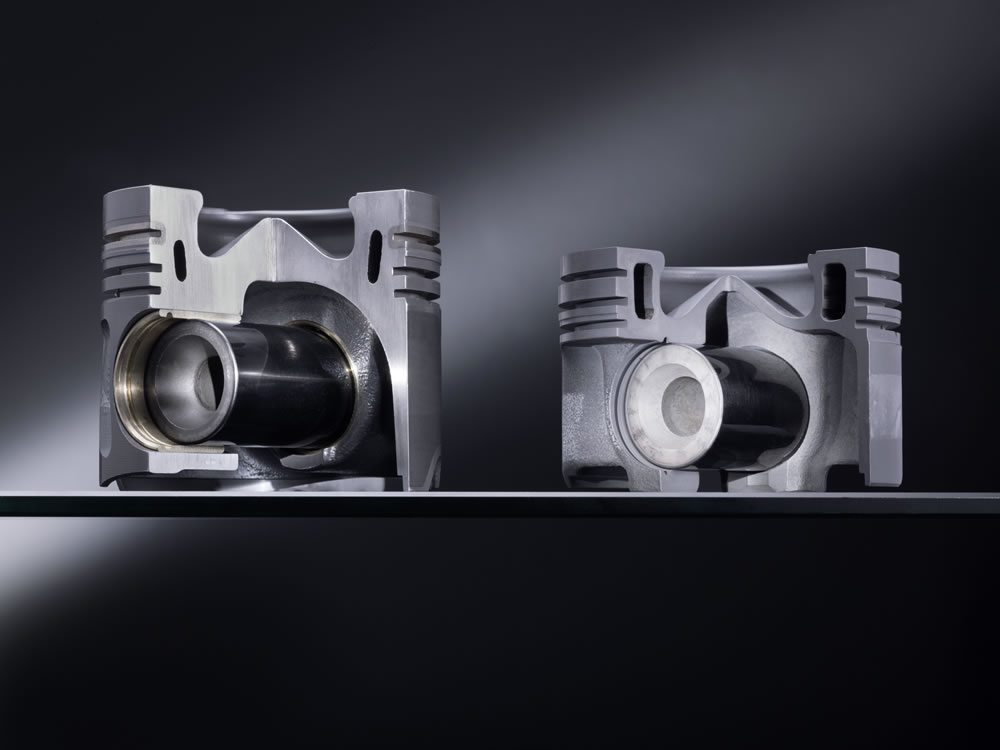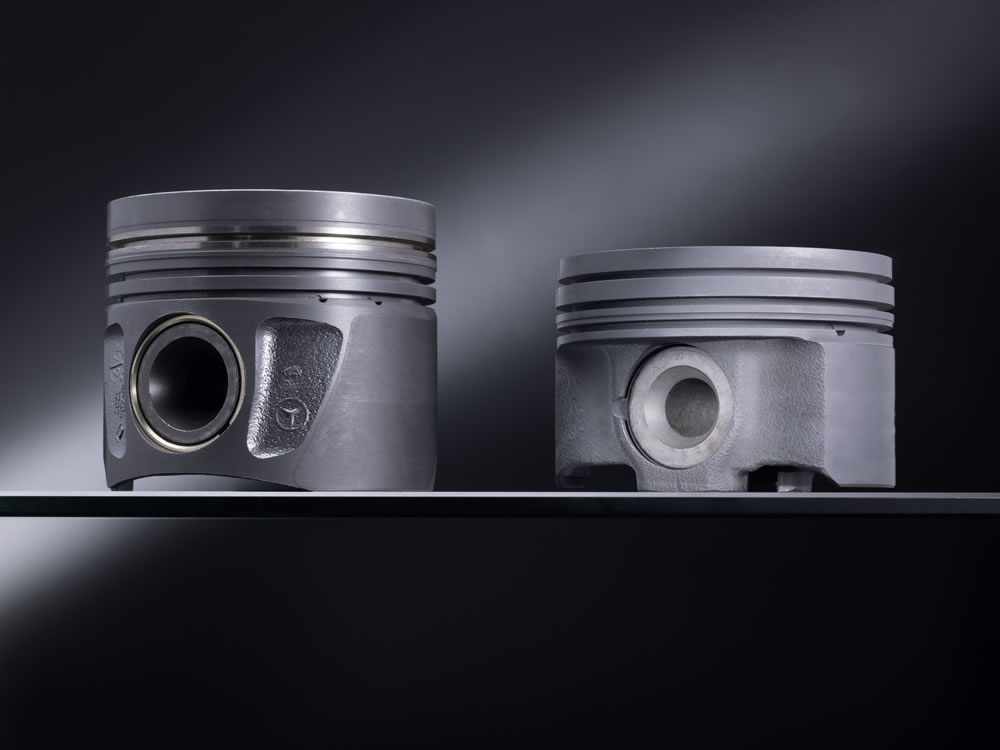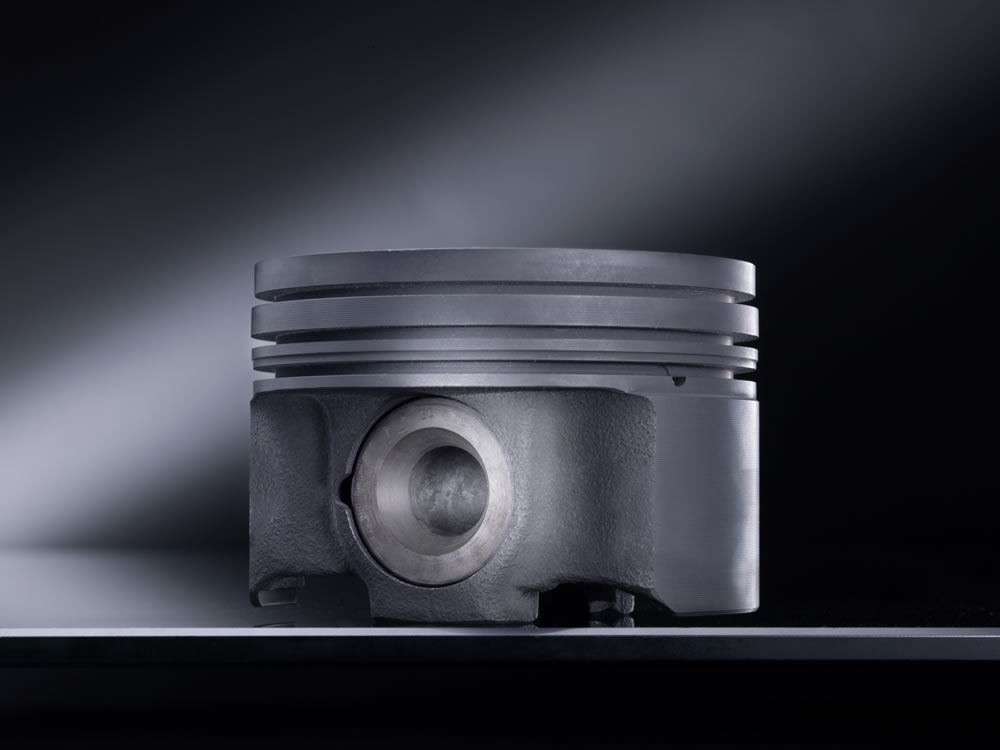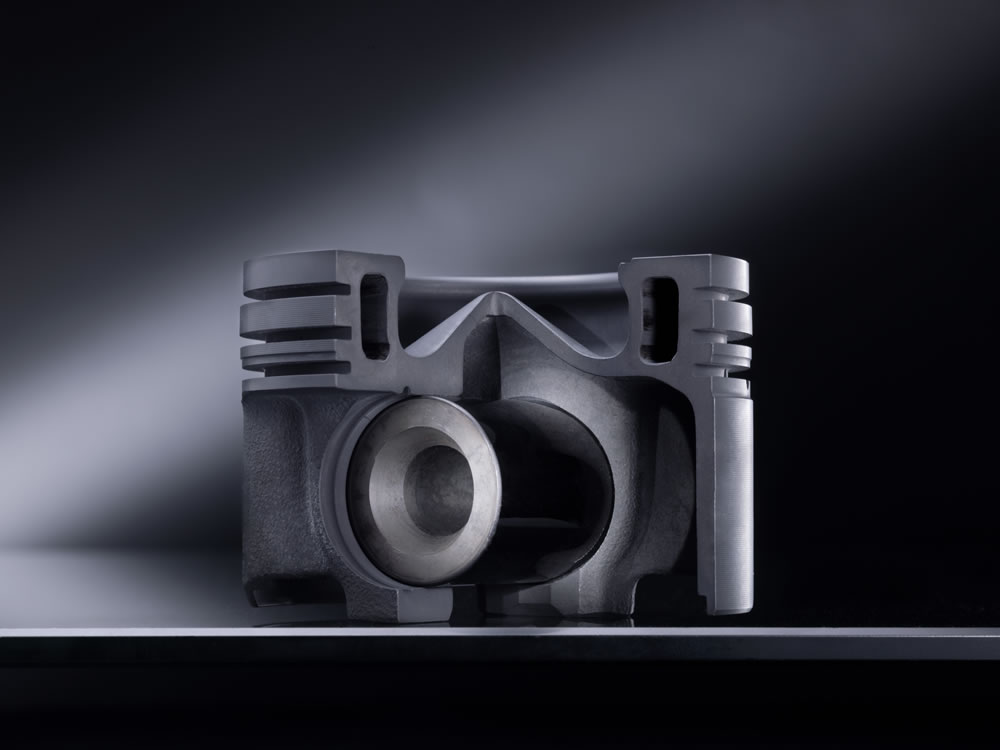Innovative engineering from Mercedes-Benz once again provides trendsetting impetus in passenger car diesel technology. The world’s pioneer in diesel technology from Stuttgart is the first to replace the hitherto conventional aluminium pistons in passenger car diesel engines with a new high-tech generation of pistons made of steel. The advantages they bring, when combined with the innovative NANOSLIDE® cylinder bore coating technology, include even lower fuel consumption and even lower CO2 emissions.

Aluminium piston (left) the new steel piston (right)
In 1936 Mercedes-Benz became the first company in the world to launch a diesel passenger car, thus taking on its role as a diesel pioneer. Stuttgart’s automotive engineers consistently reinforced this leadership position over the decades that followed through the introduction of numerous technical innovations that have contributed significantly to making the passenger car diesel engine what it is today: powerful and yet economical – in short, efficient.
The engineers are now once again working to tighten the efficiency screw. In September 2014, new high-tech steel pistons will be celebrating their world premiere in a standard-production passenger car, in the V6 diesel engine of the Mercedes-Benz E 350 BlueTEC. Thanks, amongst other things, to this technical innovation the saloon continues to deliver the same engine output (190 kW/ 258 hp), yet only uses around 5.0 litres of diesel fuel per 100 kilometres – the saving achieved through the use of the steel piston is thus around three percent.
Steel pistons are already commonly found in commercial vehicle engines, where they are combined with heavy cast-iron crankcases, while aluminium pistons have over the years gradually become the norm for passenger car diesel engines. The high-tech steel pistons that Mercedes-Benz has now developed completely from scratch harmonise perfectly with the state-of-the-art and much lighter aluminium engine housings and the multiple-award-winning NANOSLIDE® cylinder bore coating technology also developed by Mercedes‑Benz.
Exploiting material advantages
Steel and aluminium have significantly different characteristics: steel expands less than aluminium when hot, conducts heat less well and is simply heavier. At first glance, this would seem to make the combination of aluminium housing and steel pistons tricky. Notwithstanding this situation, the Mercedes-Benz engineers discovered opportunities for the future by using the apparent differences between the properties of the respective materials to their best advantage.
They exploited the fact that a steel piston only expands with heat to about a quarter of the extent of its aluminium equivalent to fit the steel piston more tightly within the aluminium housing, with the effect that it sits very snugly in the cylinder bore. However, as the temperature rises during operation of the engine, the aluminium housing expands more than the steel piston – and the result is greater tolerance of the piston within the cylinder and thus less friction. As the piston/cylinder assembly alone causes between 40 and 50 percent of the mechanical friction, the potential for efficiency revealed here was significant.
Stronger, smaller, light
The steel pistons used up until this point were, however, little suited for the combination with engine housings made of aluminium. So instead, Mercedes‑Benz had to redesign the piston. The modern versions of the steel pistons that will now be fitted for the first time as standard in the V6 diesel on board the E 350 BlueTEC, within an aluminium crankcase with NANOSLIDE® cylinder bore coating technology, are high-tech components forged out of high-quality, high-strength steel. The challenge for the piston supplier is considerable, since the manufacturing process for the new, high-strength steels is similarly complex.
But the effort is worthwhile, as the higher strength of the modern steel allows for a more compact piston design, which more or less compensates for the fact that the material is around three times as dense. Indeed, the innovative steel pistons that will in future be working away within the six combustion chambers of the Swabian V6 diesel engine are as much as 13 millimetres lower than the aluminium equivalents used until now (aluminium pistons in the V6 diesel approx. 71.6 mm high, steel pistons only 58.6 millimetres). Thanks to this changed geometry and intelligent design, the weight of the unit comprising piston, gudgeon pin and piston rings is on a par with that of the version with aluminium piston. Mercedes-Benz has thus been able to compensate almost completely for the weight disadvantage of steel and even to ensure reserves of strength for peak pressures that may become even higher in future.
High efficiency, low consumption
At the same time the use of steel pistons has enabled the engineers to improve the level of efficiency, since the lower thermal conductivity of steel compared with aluminium means that higher temperatures are reached within the combustion chamber. The ignition quality thus increases, while the combustion duration is reduced. The result is lower fuel consumption and pollutant emissions. Mercedes-Benz took account of the lower thermal conductivity of steel with design modifications such as modified cooling ducts in the pistons.
Experience has shown that the innovative steel pistons optimise thermodynamic performance and, at the same time, reduce friction significantly. Furthermore, measurements showed that in the lower and middle speed ranges, so important in everyday driving, significant consumption benefits can be achieved.
Advantage steel
As far as the future is concerned, the engine designers at Mercedes-Benz see further possible advantages in the use of the high-tech steel pistons:
Steel not only allows the piston to be made smaller, but also offers greater reserves for coping with mechanical stresses. This is particularly advantageous for further downsizing concepts
Since steel pistons are stronger than aluminium ones, a diesel engine fitted with them can operate at higher temperatures and thus achieve a higher level of thermodynamic efficiency.
Since the lower thermal expansion of steel pistons compared with aluminium also means that the engine designers are able to reduce the gap between the cylinder wall and the piston as far as the first piston ring, it has been possible to reduce both pollutants and untreated emissions.
Logical further development
These innovative steel pistons mark a logical next step in Mercedes-Benz’s work to further develop diesel technology. As they have done so often in the past, proving themselves to be true diesel pioneers at every step of the way, the Stuttgart engineers continue to work on making the diesel engine a viable proposition for the future.
The V6 diesel engine, for example, which will now be going into series production with the new steel pistons for the E 350 BlueTEC, has been through various stages of development since its first appearance in the W212 in 2008. It also benefits from a further innovation developed by Mercedes-Benz: NANOSLIDE® cylinder bore coating technology. This technology was pioneered by Daimler in 2006 in the AMG V8 petrol engine. It uses twin-wire arc spraying (TWAS) technology to melt iron/carbon wires, which it then sprays onto the inside cylinder walls of the lightweight aluminium crankcase with the help of an inert gas flow. Very fine finishing of the resulting nano-crystalline iron coating creates an almost mirror-smooth surface with fine pores, which reduces friction between the piston assembly and the cylinder wall compared with when cast-iron cylinders are used, while also being extremely resistant to wear. Further benefits: lower engine weight, reduced consumption and CO2 emissions.
All in all, the V6 diesel from Mercedes-Benz today generates significantly lower CO2 emissions than it did in its previous appearances in the E-Class. In 2009 the combined figure for the emissions from the E 320 CDI was 179 grams of CO2 per kilometre; in the next-stage E-Class of 2013 this figure was 144 grams, combined. Thanks to the use of the steel piston, amongst other things, the figure for the E350 BlueTEC is now well below 140 grams. In a parallel development, the output has increased since 2008 from 155 kW (211 hp) to the current 190 kW (258 hp).
Mercedes-Benz a step ahead in diesel technology
It is envisaged that the new pistons will very shortly also be in use in Mercedes-Benz’s four-cylinder diesel engines. Joachim Schommers, head of basic engine development at Mercedes-Benz: “We are assuming that pistons made of steel will in future also be in widespread use in passenger car diesel engines.”






